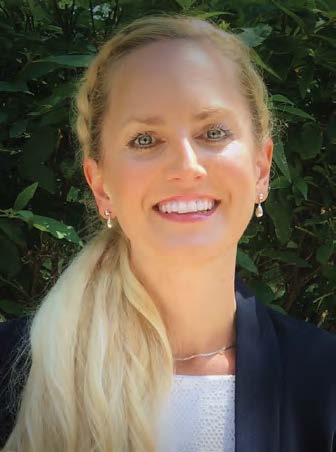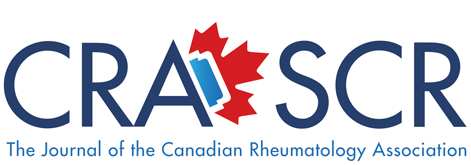Summer 2022 (Volume 32, Number 2)
The CRA's 2022 Emerging Investigator:
Dr. Jessica Widdifield
Download PDF

You are a Scientist at the Sunnybrook
Research Institute in the Holland Bone &
Joint Research Program, and ICES, as well
as an Assistant Professor at the Institute
for Health Policy, Management and
Evaluation (IHPME), where you also teach
courses on introductory and advanced
health services research methods in
the Clinical Epidemiology and Health
Services Research programs. You lead
an innovative and successful research
program, focused on outcomes and
health services research in rheumatic
and musculoskeletal diseases (RMDs).
What’s more, you already have over
60 publications providing real-world
evidence to enhance patient care, patient
outcomes, and health system efficiency
and sustainability for RMDs across the
care continuum. Can you tell us more
about your research?
The overall objective of my research program is to
contribute to knowledge to inform strategies for optimizing
care and outcomes for patients with RMDs, and to
strengthen health system capacity to optimally manage
these conditions. My research takes a population health
approach leveraging rich and diverse secondary data
sources (health records) and my contributions have focused
on four key areas of activities.
One area focuses on quantifying changes in the population-level burden of RMDs over time and health system capacity
to meet growing patient demands for these patients.
Within this area of research, I have also quantified changes
in the rheumatology workforce over time, changes in the
population-level and practice-level encounters with rheumatologists
over time (i.e. patient volumes), geographic
variation in the supply of and access to rheumatologists,
and assessed differences between male and female rheumatologists
in terms of clinical activity and remuneration.
My second research area focuses on evaluating patient
outcomes, including outcomes of disease (such as mortality),
outcomes of interventions (such as pharmacoepidemiological
assessments), and outcomes of care — the latter
of which I have a focused interest in demonstrating the
value of early access to and retention in rheumatology care
on improving outcomes.
My third area of research focuses on quality measurement,
as it’s important to monitor that care provided to patients
with RMDs is safe, effective, timely, efficient (using
resources to achieve the best possible value), equitable,
and patient-centered. Of these six
domains of quality care, I prioritize
evaluations on monitoring timeliness
of care and treatment of inflammatory
arthritis, as long wait times for rheumatology
care are one of the strongest
signals to demonstrate the lack of
health system capacity to meet patient
demands.
My fourth area of research works
in synergy with efforts distilled across
the other three areas of activities,
where I contribute to enhancing research
capacity and advancing the
science for using secondary data
(both health administrative data and
electronic medical records [EMRs])
for research and quality measurement
activities. These secondary data
sources can play an important role in guiding population
health management and evaluations of care and outcomes,
but there are uncertainties surrounding the data quality
(validity and reliability) as these data were not originally
collected for research purposes. Therefore, the use of these
data requires careful and ongoing evaluation.
It sounds like a lot, but I am fortunate to have a lot of
great collaborators to tackle these areas with me.
Your research has made important contributions to advancing
the understanding of rheumatology workforce changes, and
the population-level burden of disease, health determinants,
outcomes of care, healthcare delivery and quality of care for
patients with RMDs. What do you foresee as changes to the
Canadian rheumatology landscape in the next decade? Do you
think the rheumatology manpower shortage will be solved? If
so, how?
From a health human resources planning perspective, I am
concerned that the issues adversely affecting the rheumatology
workforce will only amplify with time. Considering that we
already have a deficit of rheumatologists, taking into account
Canada’s ongoing rapid population growth from immigration
and an aging population, and that the training of a rheumatologist
is approximately a nine-year education process (including
medical school), unless investments happen today to allow
expansion of rheumatology training programs, in 10 years
we will still be experiencing a deficit. However, the rheumatology
community is resilient, so I do not want to sound too
pessimistic. Collectively, if we prioritize efforts that invest in
strategies to strengthen rheumatology workforce capacity, I
have a more positive outlook. These efforts will need to focus on: 1) increasing recruitment of clinical full-time equivalent
rheumatologists (e.g., increasing exposure to rheumatology
in medical school, increasing rheumatology residency spots,
ethically recruiting international medical graduates); 2) improving
the regional distribution of rheumatology care across
Canada; 3) enhancing retention of rheumatologists within the
workforce; 4) promoting and enhancing workforce capacity
with interdisciplinary healthcare providers
(e.g., government,
regional, and local funding supports to expand interdisciplinary
models of care to support rheumatology practices);
5) funding research to provide data about how to more efficiently
utilize the rheumatology workforce and to better plan
for the future healthcare needs of Canada’s population; and
6) supporting equity, diversity and inclusion in rheumatology
(e.g., developing and implementing programs to enable all to
thrive, rectifying gender-based inequities in pay schedules).
From a rheumatology research and practice perspective,
I think environmental sustainability may take a more prominent
role within the rheumatology landscape in the next
decade. The health sector uses considerable energy; consumes
large quantities of plastics, paper and other resources; and
produces significant amounts of waste. It’s increasingly recognized
that we need to reduce the environmental impacts of
the health sector, so that we do not compromise our ability to
meet the needs of future generations. I think in the coming
years, it will become much more commonplace to apply an
environmental sustainability lens to every day practices. For
example, researchers will increasingly embed environmental
costs and benefits as an outcome measure or a dimension of
quality. We are going to see standard metrics and research
methods for assessing the environmental effects of health
system activities. Clinical guidelines, and care practices
will begin to incorporate environmental sustainability into
clinical decision-making (e.g., encouraging the use of telemedicine
for stable patients to reduce the carbon footprint
of transportation, adopting “pharmEcovigilance” and sustainable
use of pharmaceuticals to reduce environmental contamination
such as proper disposal of leftover drugs, adoption
of sustainable packaging for pharmaceutical products).
We may even see granting agencies and funding reviewers
(maybe even ethics review boards) scrutinize study protocols
for ethically responsible practices (e.g., are all study visits necessary
or could patient-reported outcomes be collected electronically?).
Identifying and reducing administrative waste,
and operational waste (such as unnecessary repeat testing/
imaging and other redundancies/inefficiencies) will all be increasingly
important during the next decade.
There is a saying that success is the sum of small efforts,
repeated day in and day out. For whatever is on the horizon, I
have no doubt that the rheumatology community will collectively
pitch in to address the issues affecting the sustainability
of the workforce, and also champion the environmental
sustainability movement — whereby patients, caregivers, and
researchers, see the world that surrounds us as an integral
whole.

Dr. Widdifield receiving the CRA Distinguished Investigator
Award during
the virtual gala in February 2022.
At this year’s CRA Annual Scientific Meeting Emerging
Investigator Address, you presented research findings on the
pandemic’s impact on patients and rheumatologists. What
other areas of research are you currently working on now?
My attention is now focusing on the Rheumatology EMR database
at ICES. Over the past few years, we have been aggregating
EMR data from Ontario rheumatologists into a centralized
database. There was a lot of administrative work to get
this project off the ground, with privacy and legal matters to
attend to, preparing the infrastructure to securely house the
data, and finalizing the process for extracting and acquiring
rheumatology EMR data into a central data repository. Once
the EMR data arrives, it needs to be processed, de-identified,
and data variables mapped across individual practices into a
common data model/schema, with a data dictionary to reflect
the data content and structure. Then detailed data quality
assessments are undertaken to inform which research questions
can be feasibly and accurately addressed using the data.
Recruitment of rheumatologists to participate (in sharing a
copy of their practice data) is being done in phases and expansion
of participants is underway. This novel data source
will provide tremendous opportunities for collaborative research
activities with the larger rheumatology community to
really harness the power of using EMR data for research and
quality measurement and improvement activities.
What has been your proudest professional accomplishment to
date?
It’s difficult to single out my proudest moment, as different
accomplishments have impacted me in different meaningful
ways. Being awarded a Banting Postdoc Award brought me
to tears, so that was definitely the most emotional accomplishment,
as a CIHR peer review panel felt I was deserving
to continue my training towards an independent research career.
That gave me a much-needed confidence boost (at a time
when I needed it the most). Receiving a Stars Career Development
Award from the Arthritis Society was also an important
milestone. Starting out as a new investigator can be overwhelming,
constantly being pulled in different directions, as other
internal and external forces may be directly or indirectly influencing
research activities we undertake. The Stars Award
helped me to prioritize my research program. And of course,
I am deeply honoured to be the recipient of the 2022 CRA’s
Emerging Investigator Award. To be recognized by my peers
for my contributions to rheumatic disease research in Canada
is very special.
Jessica Widdifield, PhD
Scientist, Sunnybrook Research Institute, (Holland Bone &
Joint Research Program), ICES
Assistant Professor, University of Toronto,
Institute of Health Policy, Management & Evaluation
Toronto, Ontario
|
